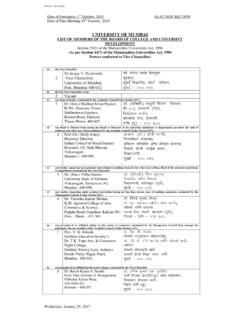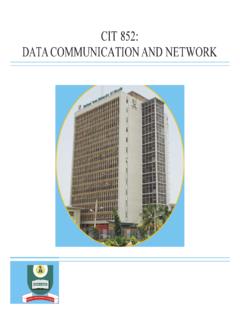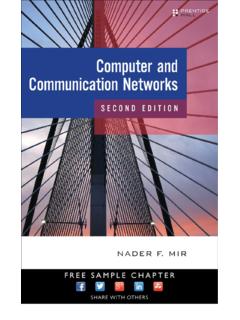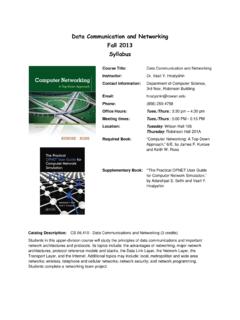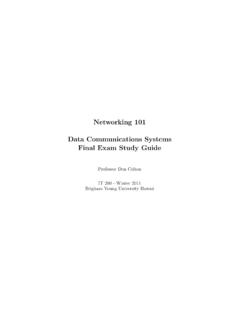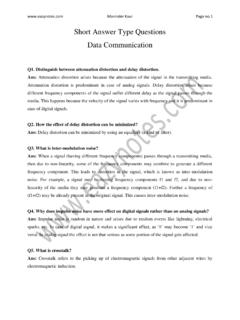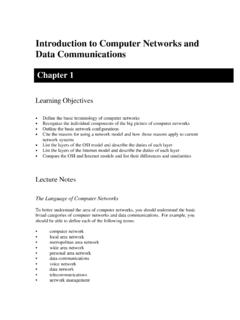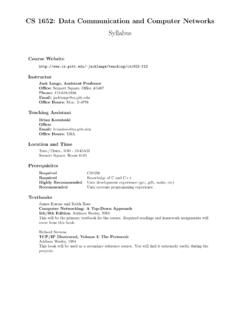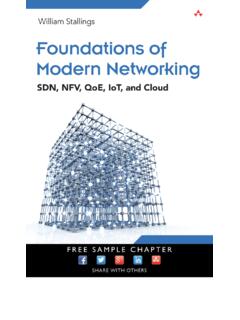Transcription of NETWORKING FUNDAMENTALS - Mu
1 1 Unit 1. Introduction to data communications and NETWORKING 1 NETWORKING FUNDAMENTALS Unit Structure Objectives Introduction data & Information data communication Characteristics of data communication Components of data communication data Representation data Flow Simplex Half Duplex Full Duplex Computer Network Categories of a network Protocol Elements of a Protocol Standards In NETWORKING Concept of Standard Standard Organizations in field of NETWORKING Review Questions References
2 OBJECTIVES: Introduce the readers to data communication and its FUNDAMENTALS Define networks Define protocols Standards in NETWORKING 2 INTRODUCTION This chapter provides an introduction to Computer networks and covers fundamental topics like data , information to the definition of communication and computer networks. The main objective of data communication and NETWORKING is to enable seamless exchange of data between any two points in the world. This exchange of data takes place over a computer network.
3 data & INFORMATION data refers to the raw facts that are collected while information refers to processed data that enables us to take decisions. Ex. When result of a particular test is declared it contains data of all students, when you find the marks you have scored you have the information that lets you know whether you have passed or failed. The word data refers to any information which is presented in a form that is agreed and accepted upon by is creators and users. data communication data communication is a process of exchanging data or information In case of computer networks this exchange is done between two devices over a transmission medium.
4 This process involves a communication system which is made up of hardware and software. The hardware part involves the sender and receiver devices and the intermediate devices through which the data passes. The software part involves certain rules which specify what is to be communicated, how it is to be communicated and when. It is also called as a Protocol. The following sections describes the fundamental characteristics that are important for the effective working of data communication process and is followed by the components that make up a data communications system.
5 Characteristics of data communication The effectiveness of any data communications system depends upon the following four fundamental characteristics: 3 1. Delivery: The data should be delivered to the correct destination and correct user. 2. Accuracy: The communication system should deliver the data accurately, without introducing any errors. The data may get corrupted during transmission affecting the accuracy of the delivered data . 3. Timeliness: Audio and Video data has to be delivered in a timely manner without any delay; such a data delivery is called real time transmission of data .
6 4. Jitter: It is the variation in the packet arrival time. Uneven Jitter may affect the timeliness of data being transmitted. Components of data communication A data communication system has five components as shown in the diagram below: Fig. Components of a data communication System 1. Message Message is the information to be communicated by the sender to the receiver. 2. Sender The sender is any device that is capable of sending the data (message). 3. Receiver The receiver is a device that the sender wants to communicate the data (message).
7 4. Transmission Medium It is the path by which the message travels from sender to receiver. It can be wired or wireless and many subtypes in both. 4 5. Protocol It is an agreed upon set or rules used by the sender and receiver to communicate data . A protocol is a set of rules that governs data communication . A Protocol is a necessity in data communications without which the communicating entities are like two persons trying to talk to each other in a different language without know the other language.
8 data REPRESENTATION data is collection of raw facts which is processed to deduce information. There may be different forms in which data may be represented. Some of the forms of data used in communications are as follows: 1. Text Text includes combination of alphabets in small case as well as upper case. It is stored as a pattern of bits. Prevalent encoding system : ASCII, Unicode 2. Numbers Numbers include combination of digits from 0 to 9. It is stored as a pattern of bits. Prevalent encoding system : ASCII, Unicode 3.
9 Images An image is worth a thousand words is a very famous saying. In computers images are digitally stored. A Pixel is the smallest element of an image. To put it in simple terms, a picture or image is a matrix of pixel elements. The pixels are represented in the form of bits. Depending upon the type of image (black n white or color) each pixel would require different number of bits to represent the value of a pixel. The size of an image depends upon the number of pixels (also called resolution) and the bit pattern used to indicate the value of each pixel.
10 Example: if an image is purely black and white (two color) each pixel can be represented by a value either 0 or 1, so an image made up of 10 x 10 pixel elements would require only 100 bits in memory to be stored. On the other hand an image that includes gray may require 2 bits to represent every pixel value (00 - black, 01 dark gray, 10 5 light gray, 11 white). So the same 10 x 10 pixel image would now require 200 bits of memory to be stored. Commonly used Image formats : jpg, png, bmp, etc 4. Audio data can also be in the form of sound which can be recorded and broadcasted.





